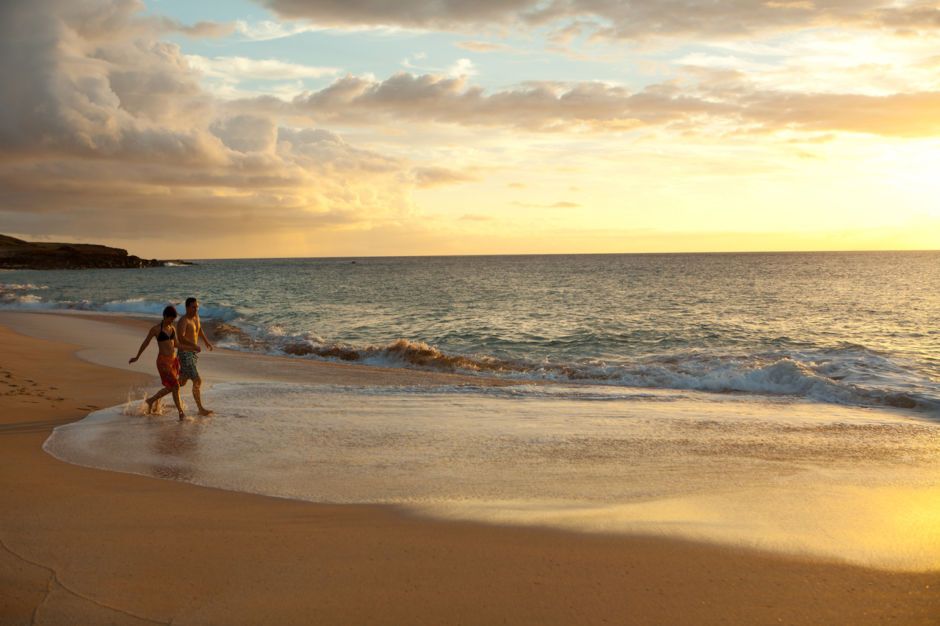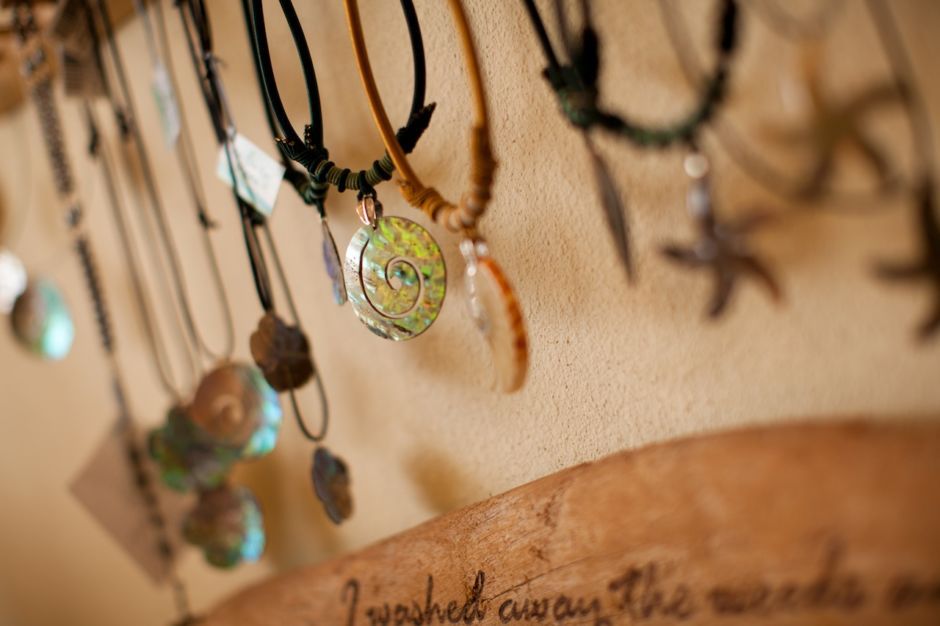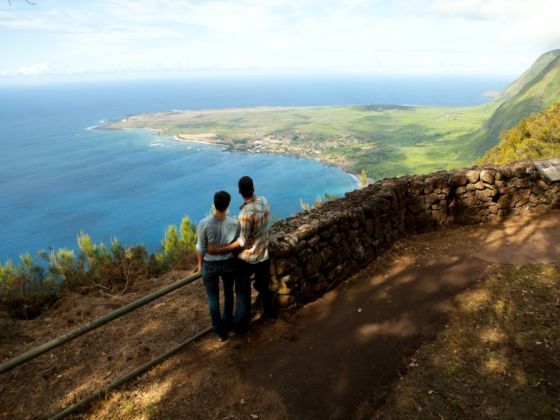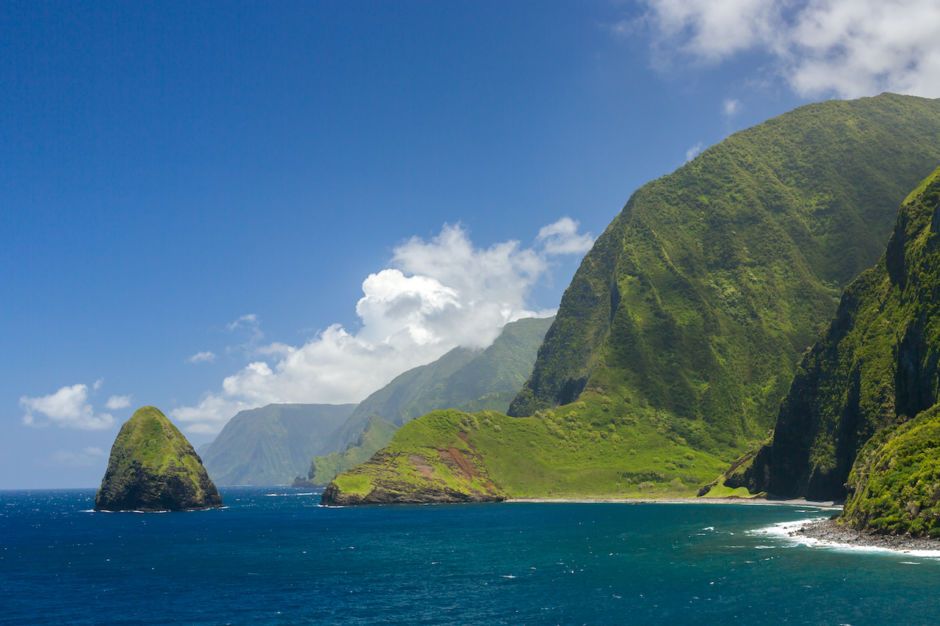Molokai may be the “Friendly Isle,” but don’t let that name fool you into imagining resort-side luaus and collared hospitality. The island is a quiet place that reflects a more traditional Hawaii.
Here, sea cliffs rise higher than you’ve ever seen. Verdant valleys and massive sand dunes punctuate the coast, and the most “populous” town has under 4,000 residents. Molokai lacks the spectacle that so often comes with island getaways — no top-dollar resorts, no packaged experiences — and instead focuses on serenity. On simplicity. Once you have the chance to experience it, you’ll quickly feel just like the locals do: “Molokai (is) Mo Bettah.”
General travel tips
From the moment you touch down at the airport (flying from Maui or Oahu), you’ll realize Molokai isn’t your average Hawaiian vacation island. For starters, the airport is tiny, just like the island itself (38 miles long by 10 miles wide). The fastest speed limit is 45mph. People wave. Everything is slower and simpler here.
Unless you’re planning on a cycling vacation — which, by the way, would be an excellent idea — you’ll need a car. Alamo is the only national rental agency at the airport; there are a couple of small, local rental companies, like Molokai Car Rental, that offer a more affordable alternative. However you choose to do it, getting around is pretty simple — the island’s main drag has markers at every mile, often used to denote a site’s location.
The 57-room Hotel Molokai, a few minutes from the main town of Kaunakakai, steals the accommodation spotlight with its lively activity desk, restaurant, pool, and oceanfront views. Other lodging options include a variety of vacation rentals, condos, and cottages.
Note: If you’re into cycling and sustainability — two very popular things on Molokai — check out Molokai Bicycle. Philip will hook you up with everything you need and everything you need to know to get around. It’s a great way to travel with respect for the island and its communities.
Molokai by land

Photo: Tor Johnson/Hawaii Tourism Authority
Molokai was formed by two volcanoes: Wailau (East Molokai Volcano) and Mauna Loa (West Molokai Volcano). The island used to be much bigger, but over a million years ago, a third of it collapsed into the Pacific. Remnants of that catastrophic event, dramatic sea cliffs rise more than 3,300 feet above the ocean waves around the scenic Kalaupapa Peninsula. They’re among the tallest in the world.
You can view the cliffs at Kalaupapa National Historical Park, a hauntingly beautiful landscape with a somber past. In 1866, it became a place of banishment for those suffering from Hansen’s disease, aka leprosy, and thousands died here in isolation, the crashing waves and jagged cliffs more a prison than a paradise. To visit, guests must be sponsored by a resident or go with a tour group. Currently, the park is fully closed due to Covid-19 — check the NPS website for updates.
If you’re set on seeing the cliffs but can’t get hold of a permit, head to Palaau State Park. In addition to hiking trails that lead deep into ironwood forest, there’s a stunning overlook of Kalaupapa (from about 1,000 feet above the peninsula). Note: You can book a helicopter tour from Maui to view the cliffs as well.
Kalaupapa may be the big attraction here, but know that other areas of the island are just as remarkable. Molokai’s northwest coast is protected as the Moomomi Preserve, one of the last intact coastal sand dune ecosystems on the islands. There are two miles of wave-carved dunes, acres of rare native flora, and plenty of wildlife — including sea turtles.
Another major draw for adventurers looking to connect with Hawaii’s history is the Halawa Valley, where you can trek through private property to the double-tiered 250-foot Mooula Falls. The born-and-raised guides from Halawa Valley Falls Cultural Hike will help you navigate the dense rainforest to the waterfall pond for a swim.
Molokai by sea

Photo: Dana Edmunds/Hawaii Tourism Authority
Molokai is surrounded by stunning reefs (be sure to get a window seat on the plane!), particularly on the south coast. These fringing reefs, Hawaii’s longest, stretch continuously for 28 miles. There isn’t a lot of deep water near the beaches for swimming, so hopping on a boat — be it a kayak or a fishing charter — should be front and center on your ocean itinerary. Deep-sea fishing is one of the most popular activities on Molokai, as is whale watching (in season, December through May) and snorkeling, all of which are best done on a guided tour.
For any or all of these activities, hit up Molokai Fish and Dive. On their snorkeling and scuba diving trips, a small team — three captains and four divemasters — will take you out to reef walls and deep blue holes. Whale-watching tours, meanwhile, will focus on the the Kaiwi and Kalohi channels, where humpbacks tend to congregate in the “chillier” months.
All this begs the question: This is Hawaii after all, so what about the beaches? While Molokai is more about community and sustainability than sunbathing, there is one you’ll want to explore: Papohaku Beach. It’s three miles long and rarely crowded. The breaks can be quite large, especially in winter — leave the surfing to the pros and, instead, just lie back and soak in your serene surroundings.
Sightseeing and shopping

Photo: Dana Edmunds/Hawaii Tourism Authority
If you’ve waited all of your life to paint and mail a coconut as a postcard, now’s your chance — stop in at the Hoolehua Post Office to Post-a-Nut. Afterward, check out the Molokai Museum & Cultural Center to learn about the island’s history, particularly that of the people who lived and continue to live in Kalaupapa. This is a perfect place to talk story with locals and really dig deep.
Another good time to talk story is while shopping. Perhaps it comes as a surprise, but the shopping on this small island is pretty exceptional. Big Wind Kite Factory in the almost-ghost town of Maunaloa is a fun excursion, while Blue Monkey is a great place to stock up on souvenirs (and maybe pick up a ukulele?). Back in Kaunakakai, stroll along and around Ala Malama Avenue to find an array of local shops, clothing boutiques, and restaurants.
Dining and drinking

Photo: Blake Bronstad/Hawaii Tourism Authority
Leave your sport coat at home, because dining on Molokai is the definition of laid back. Hiro’s Ohana Grill at Hotel Molokai is about as upscale as it gets, and you’ll definitely want to eat at least one meal here, what with the stunning ocean views, evening entertainment, and daily fresh catch.
Paddlers Restaurant and Bar also offers a more elevated menu, with a large selection of pupus (appetizers) that go great with a beer and the night’s live music. For more casual meals — including Hawaiian favorites like the loco moco, plate lunch, or teriyaki burger — visitors and residents alike love Kualapuu Cookhouse, Manae Goods & Grindz, Molokai Burger, and the vegan-friendly Hula Bean Cafe.
Whatever you do, make sure to stop into Kanemitsu Bakery & Coffee Shop for breakfast — it’s the only restaurant on the island that’s been nominated for a James Beard Award. Pay another visit around 7:30pm (this time you’re looking for the back door, down the alley) for their famous Molokai Sweet Bread, full of sweet, creamy stuffing choices, straight from the oven to your mouth. Yep, the simple pleasures are Molokai’s specialty.


